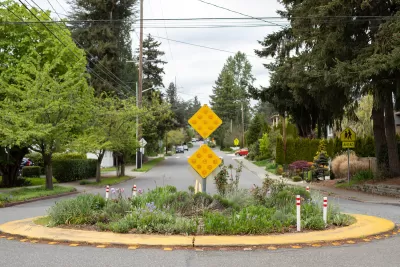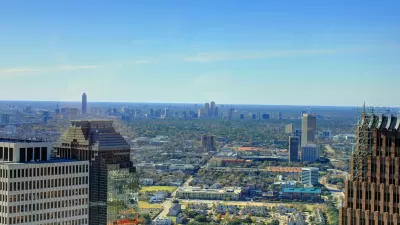Explore the trajectory of federal investment in green city projects, focusing on sustainable infrastructure, renewable energy, and eco-friendly policies.

Green city initiatives make cities more sustainable by using eco-friendly tools like energy efficiency, waste management, and open spaces. These practices are growing, focusing on sustainable urban development.
However, cities often need more funds to embrace these efforts fully. Federal funding is vital to boost and ensure widespread adoption, creating eco-friendly and resilient urban areas.
Government programs and policies
These government initiatives highlight a commitment to green city development, supporting eco-friendly urban planning and sustainable transportation:
Environmental Protection Agency's (EPA) Smart Growth Program
This program promotes sustainable urban planning and emphasizes environmentally conscious development strategies. It encourages compact, walkable communities, reducing urban sprawl.
Portland, Oregon, implemented smart growth policies, leading to increased public transit use and a vibrant city center. Currently, 51 percent of Portland's waterproof surfaces are managed by green stormwater infrastructure.
Department of Transportation's (DOT) Transportation Investments Generating Economic Recovery (TIGER) Program
This program funds transportation projects for economic growth by focusing on resilient and sustainable transportation systems. The TIGER-funded Indianapolis Cultural Trail improved mobility, boosted economic activity, and promoted sustainable transportation.
The importance of green infrastructure
Green infrastructure, such as parks and open spaces, acts as a natural buffer against environmental challenges like floods and extreme weather events. President Biden signed the $1.2 trillion Infrastructure Investment and Jobs Act (IIJA) into law, allocating $550 billion over the next five years for U.S. infrastructure.
The focus is improving roads, bridges, public transportation, and water systems. The IIJA prioritizes funding for climate mitigation, social equity, and environmental justice. Incorporating green elements helps preserve biodiversity within urban areas, promoting a healthier ecosystem and supporting various plant and animal species.
Trees and green roofs absorb carbon dioxide, mitigating the urban heat island effect and helping combat climate change, creating a more sustainable urban environment. Healthy wetlands and forests act as natural sponges, absorbing and storing water to recharge groundwater supplies. This approach supports long-term sustainability in the United States and provides over 68,000 communities with filtered drinking water.
Green infrastructure aids in managing stormwater, reducing runoff, and preventing flooding. This sustainable approach to water management enhances a city's adaptability to changing climate patterns.
Innovative building lighting systems automatically adapt to occupancy and natural light, reducing energy use and expenses. They're also remotely controllable and offer convenient customization options. Access to green spaces improves city dwellers' physical and mental well-being to create a more livable and enjoyable urban development.
Funding opportunities for green infrastructure
These federal funding opportunities provide financial support for cities and communities looking to implement green infrastructure projects, promoting sustainability, environmental resilience, and improved urban living conditions:
- EPA's Clean Water State Revolving Fund (CWSRF): Supports infrastructure projects emphasizing water quality improvement. Local governments can apply for low-interest loans and grants to fund projects like green stormwater management systems.
- HUD's Community Development Block Grant (CDBG) Program: Addresses community development needs, including infrastructure projects. Cities can apply for grants to fund various initiatives, including green infrastructure projects and enhancing community sustainability.
- Transportation Infrastructure Finance and Innovation Act (TIFIA): Targets transportation projects incorporating green elements. State and local governments and private entities can apply for low-interest loans to fund sustainable transportation infrastructure projects.
- USDA Rural Development Water and Environmental Program: Supports water and waste management projects in rural areas. Rural communities can access loans, grants, and guarantees to implement green infrastructure solutions for sustainable water management.
Successful green infrastructure projects
Here are some case studies demonstrating the successful implementation of green infrastructure projects supported by federal programs:
- Philadelphia Green City, Clean Waters Program: The program was funded by EPA's CWSRF. Philadelphia implemented green stormwater management practices, including rain gardens and permeable pavements, reducing stormwater runoff and improving water quality. Hundreds of structures and buildings, along with 10,000 acres of public common space, are managed by Philadelphia Parks and Recreation.
- Portland's Sustainable Stormwater Management: Portland utilized federal funding like EPA's CWSRF and HUD's CDBG program to implement green infrastructure projects such as eco-roofs and streets. These initiatives managed stormwater effectively and enhanced the city's overall sustainability.
- Lost Angeles River Revitalization: HUD's CDBG's federal funding supported the revitalization of the Los Angeles River, integrating green spaces, bike paths, and recreational areas.
Implementing green city initiatives
Federal funding for green city projects is looking promising. Governments are increasingly recognizing the importance of supporting eco-friendly practices. Continued investment in green infrastructure, renewable energy, and adaptive policies is essential for creating vibrant, inclusive, resilient cities.

Manufactured Crisis: Losing the Nation’s Largest Source of Unsubsidized Affordable Housing
Manufactured housing communities have long been an affordable housing option for millions of people living in the U.S., but that affordability is disappearing rapidly. How did we get here?

Americans May Be Stuck — But Why?
Americans are moving a lot less than they once did, and that is a problem. While Yoni Applebaum, in his highly-publicized article Stuck, gets the reasons badly wrong, it's still important to ask: why are we moving so much less than before?

Using Old Oil and Gas Wells for Green Energy Storage
Penn State researchers have found that repurposing abandoned oil and gas wells for geothermal-assisted compressed-air energy storage can boost efficiency, reduce environmental risks, and support clean energy and job transitions.

Updating LA’s Tree Rules Could Bring More Shade to Underserved Neighborhoods
A new USC study finds that relaxing Los Angeles’ outdated tree planting guidelines could significantly expand urban tree canopy and reduce shade disparities in lower-income neighborhoods, though infrastructure investments are also needed.

California's Canal Solar Projects Aim to Conserve Resources and Expand Clean Energy
California’s Project Nexus has begun generating electricity from solar panels installed over irrigation canals, with researchers and state agencies exploring statewide expansion to conserve water and boost clean energy production.

HHS Staff Cuts Gut Energy Assistance Program
The full staff of a federal program that distributes heating and cooling assistance for low-income families was laid off, jeopardizing the program’s operations.
Urban Design for Planners 1: Software Tools
This six-course series explores essential urban design concepts using open source software and equips planners with the tools they need to participate fully in the urban design process.
Planning for Universal Design
Learn the tools for implementing Universal Design in planning regulations.
Heyer Gruel & Associates PA
City of Moreno Valley
Institute for Housing and Urban Development Studies (IHS)
City of Grandview
Harvard GSD Executive Education
Salt Lake City
NYU Wagner Graduate School of Public Service
City of Cambridge, Maryland






























